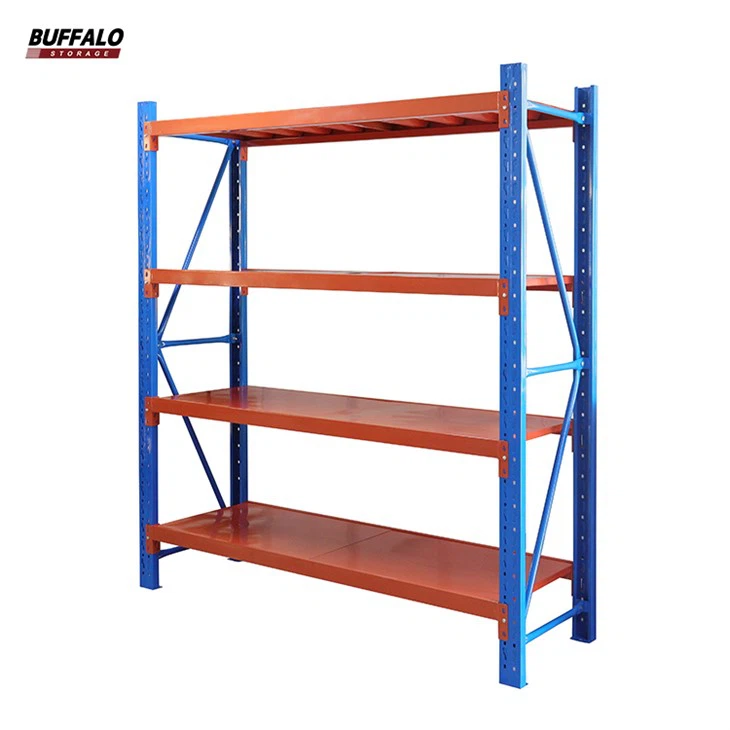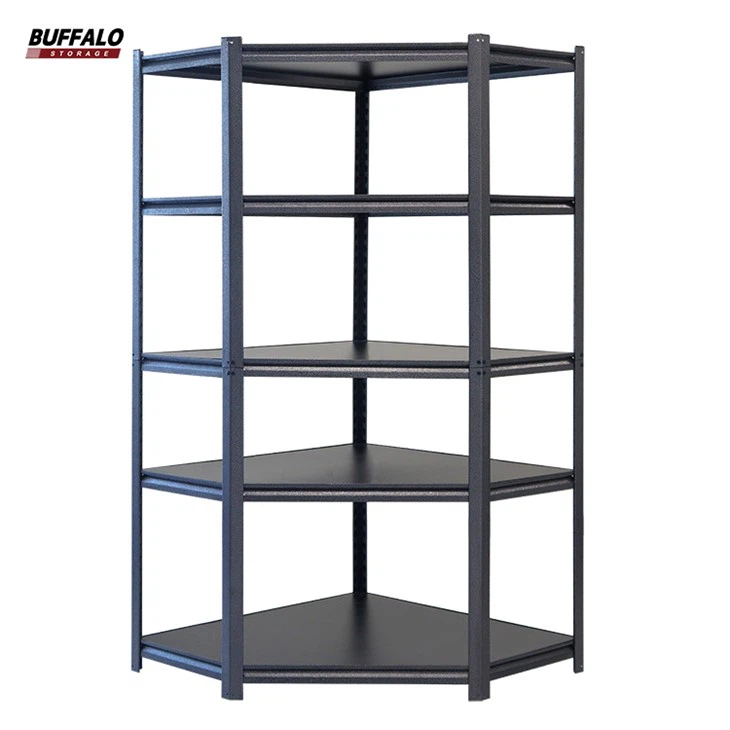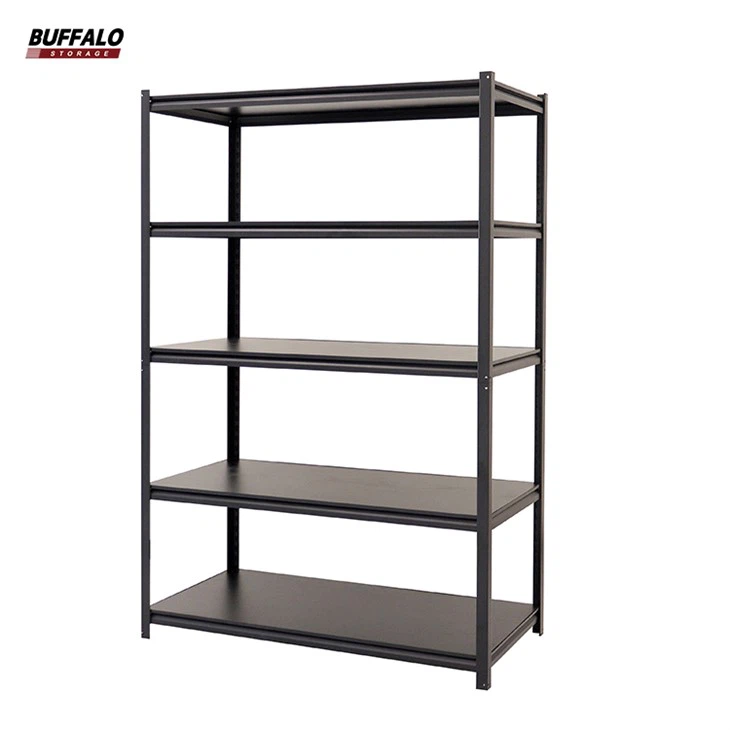Ist Ihr Lagerhaus Kampf mit überquellenden Beständen, verschwendete vertikale Raumund ineffizient Palette Handhabung? Diese Desorganisation führt zu Produktivitätsverlusten, potenziellen Produktschäden, erschwertem Zugang zu den Beständen und schränkt letztlich Ihre entscheidende Speicherkapazität. Lösen Sie diese Herausforderungen mit robusten, verstellbares Palettenregal Systeme von einem vertrauenswürdigen Regalproduktion Produktionsstätte.
Verstellbare Palettenregalsysteme sind die häufigsten und vielseitigsten Lagerungslösung. Sie nutzen die vertikale Palettenregalrahmen (Stützen) und horizontale Belastung Balken die leicht und ohne Werkzeug umpositioniert werden können. Diese Racksystem ermöglicht direkte Gabelstapler Zugang zu jedem Paletteund bietet maximale Flexibilität für verschiedene Palette Größen, Bestandsarten und Veränderungen Speicherbedarf. Sie sind darauf ausgelegt, die Lagerfläche, verbessern Bestandsverwaltungund die allgemeine betriebliche Effizienz durch organisierte Palettenlagerung.
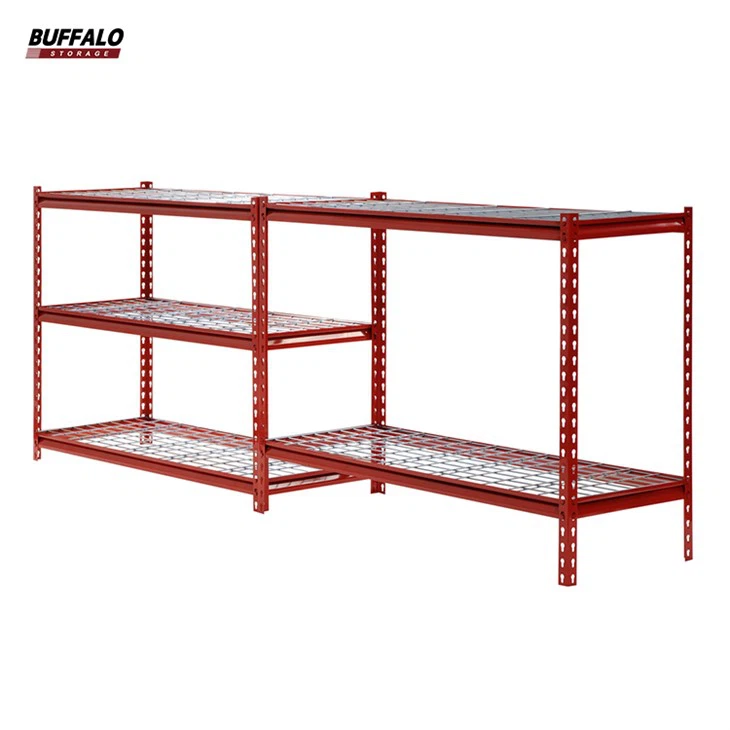
Hochleistungs-Metallregal1
Als engagierter Regalproduktion Produktionsstättesind wir spezialisiert auf die Erstellung hochwertiger Gestelle und Regale. Wir verstehen, dass für unsere Kunden - Einzelhändler, Online-E-Commerce-Verkäufer, Lagerausstatter, Eisenwaren-Großhändler und Baumaterialien-Käufer - Produktqualität, Strukturdesign, Tragfähigkeit, Stabilität, Und Produktlebensdauer sind von entscheidender Bedeutung. Dieser Leitfaden untersucht die wesentlichen Aspekte der verstellbare Palettenregalanlagenund zeigen, warum sie das Rückgrat der modernen Wirtschaft sind. Lagerhaltung.
Was genau ist ein Palettenregalsystem?
A Palettenregalanlage ist ein Materialtransportunternehmen Speichersystem speziell für die Lagerung von Materialien auf Paletten (oder Kufen). Es ist die grundlegende Struktur, die es ermöglicht Lagerhallen und Vertriebszentren, um den vertikalen Raum effizient zu nutzen. Anstatt zu stapeln Paletten direkt übereinander liegen (was die Waren beschädigen und die Zugänglichkeit einschränken kann), ein Palettenregal schafft horizontale Ebenen oder Regale von aufrechten Rahmen getragen.
Diese Regalsysteme sind so konstruiert, dass sie schwere Lasten sicher tragen und die Handhabung von Geräten, vor allem Gabelstaplerum leicht auf einzelne Informationen zuzugreifen und diese abzurufen Paletten. Die Kernidee besteht darin, dichte, organisierte und zugängliche Palettenlagerung. Verschiedene Arten von Palettenregalen existieren, aber die grundlegendste und am weitesten verbreitete ist die verstellbares Palettenregaloft auch bezeichnet als Selektive Palettenregale.
Aus unserer Sicht als Hersteller ist ein gut durchdachtes Palettenregalanlage ist nicht einfach nur Stahl; es ist eine technische Lösung. Wir konzentrieren uns auf die Präzision der Komponenten, die Qualität der Materialien und die Integrität der Strukturdesign um Sicherheit und Langlebigkeit für anspruchsvolle Lagerhaus Umgebungen.
Warum ist die Verstellbarkeit von Palettenregalen im Lager von entscheidender Bedeutung?
Der "anpassbare" Aspekt von verstellbare Palettenregalanlagen ist wohl sein wichtigster Vorteil. Dies bezieht sich auf die Möglichkeit, die vertikale Position der horizontalen Last leicht zu ändern Balken die die Paletten. Warum ist das so wichtig?
- Flexibilität für abwechslungsreiches Inventar: Lagerhaus Der Bestand bleibt selten statisch. Produkte ändern sich, Palette Größen variieren, und die Speicheranforderungen entwickeln sich. Einstellbare Balken ermöglichen eine schnelle Anpassung der Regalhöhen an unterschiedliche Ladungsgrößen, ohne dass das gesamte System demontiert werden muss. Racksystem. Diese Anpassungsfähigkeit ist von entscheidender Bedeutung für Unternehmen, die mit verschiedenen Produktlinien arbeiten, wie Einzelhändler oder E-Commerce-Anbieter.
- Maximierung der Raumausnutzung: Die Verstellbarkeit sorgt dafür, dass Sie keine wertvolle vertikale Fläche verschwenden. Stauraum. Sie können einstellen Strahl gerade hoch genug für Ihre aktuelle Palette Lasten und minimiert den leeren Raum über ihnen. Dies führt direkt zu erhöhte Speicherkapazität innerhalb der gleichen Grundfläche.
- Zukunftssicher machen: Ein verstellbares Gestell System kann sich an künftige Änderungen Ihres Geschäfts- oder Bestandsprofils anpassen, was es zu einer langfristigen Investition macht. Als Ihr Speicherbedarf ändern, Ihr Regallösung können sich mit ihnen verändern.
- Leichte Implementierung: Die meisten verstellbare Palettenregalbalken verwenden Sie ein tropfenförmiges oder ähnliches Schlitzdesign, das ohne Schrauben sicher mit den Pfostenrahmen verbunden wird (Sicherheitsclips sind jedoch unerlässlich). Dies macht das Einstellen Strahl Ebenen schnell und unkompliziert, oft ohne Spezialwerkzeug.
Als Hersteller entwerfen wir unsere verstellbares Palettenregal Komponenten für eine nahtlose Integration und einfache Änderung. Die Strukturdesign sorgt dafür, dass trotz der Verstellbarkeit die Stabilität der Regale und seine Tragfähigkeit sind bei richtiger Anwendung nie gefährdet. Diese Flexibilität ist der Schlüssel zu einer effizienten Lagerhaltung Strategie.
Was sind die Hauptbestandteile eines verstellbaren Palettenregals?
Das Verständnis der Kernkomponenten hilft zu verstehen, wie ein verstellbares Palettenregalsystem Funktionen und warum Produktqualität in jedem Teil zählt:
- Upright Frames (oder Uprights): Dies sind die vertikalen Säulen, die die Hauptstruktur des Dokuments bilden. Gestell. Sie bestehen aus zwei Pfosten, die durch horizontale und diagonale Verstrebungen verbunden sind. Die Pfosten weisen in regelmäßigen Abständen Verbindungspunkte (wie Tränenlöcher) auf, an denen die Balken anbringen. Die Höhe und Tiefe der Palettenregalrahmenbestimmen zusammen mit der Stahldicke die Gesamt Tragfähigkeit Und Stabilität der Einzelregalanlage oder Bucht.
- Lastträger (oder Querbalken): Dies sind die horizontalen Strukturelemente, die die Verbindung zwischen den Pfosten herstellen. Paletten direkt auf diesen beruhen Balken. Palettenregal-Träger gibt es in verschiedenen Längen, Höhen (Stirnseitengröße) und Kapazitäten, um unterschiedlichen Lastanforderungen und Palette Größen. Sie verfügen über Verbindungsclips an beiden Enden, die in die Pfosten einrasten. Die Verstellbarkeit entsteht durch das Verschieben dieser Balken den Pfosten hoch oder runter.
- Sicherheitsclips/Schlösser: Diese kleinen, aber wichtigen Geräte sichern die Strahl an den Pfosten, um ein versehentliches Verrutschen durch Gabelstapler Aufprall beim Be- und Entladen. Eine ordnungsgemäße Installation ist für die Sicherheit von entscheidender Bedeutung.
- Grundplatten: Diese Platten befinden sich am unteren Ende jedes Pfostens und verteilen die Last auf die Lagerhaus Boden und bieten Verankerungspunkte für die Befestigung der Gestell auf den Beton, wesentlich für Erdbebengebiete und insgesamt Stabilität.
- (Optional) Palettenstützen: Dies sind Querstangen, die zwischen der Hauptlast Balkenund bietet zusätzliche Unterstützung für die Palette oder nicht standardisierte Lasten. Sie sind besonders nützlich, wenn die Art der gelagerten Palette schwach oder inkonsistent ist.
- (Optional) Drahtbelag: Oft auf der Oberseite des BalkenDrahtdecks schaffen eine flache Regal Oberfläche, verbessern die Sicherheit, indem sie das Durchfallen von Gegenständen verhindern, und ermöglichen das Eindringen von Sprinklerwasser.
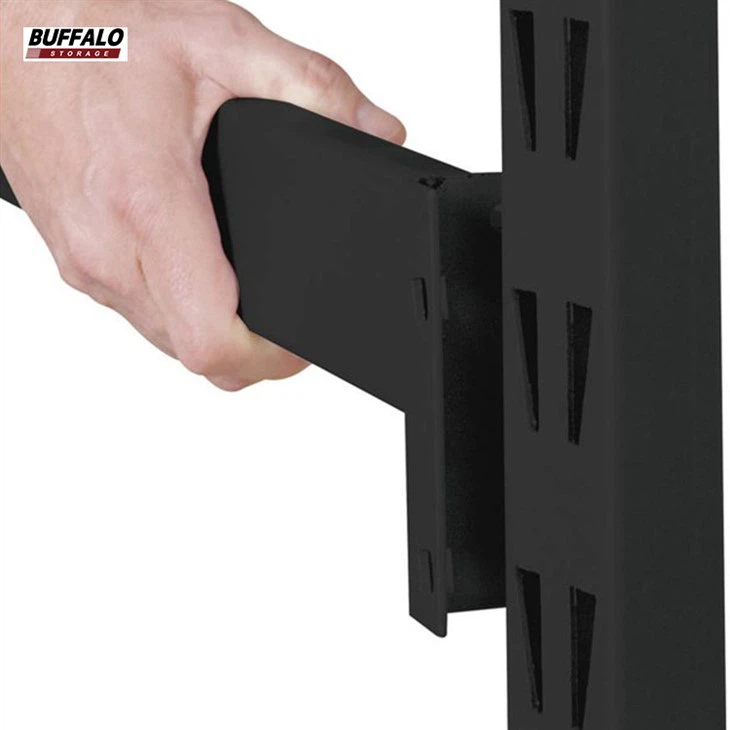
Industrielle Lagerregale2
Als Hersteller mit Schwerpunkt auf Produktlebensdauerstellen wir sicher, dass jede Komponente - von der Regalständer bis hin zum kleinsten Sicherheitsclip - wird unter Einhaltung strenger Toleranzen aus hochwertigem Stahl gefertigt und trägt so zu einer sicheren und zuverlässigen Speichersystem.
Wie funktioniert das selektive Palettenregal?
Selektive Palettenregale ist die häufigste Art von verstellbares Palettenregalsystem. Sein entscheidendes Merkmal ist, dass es Folgendes bietet direkter Zugang zu jeder Palette gespeichert in der Gestell. Dies bedeutet eine Gabelstapler Operator kann jede einzelne Datei laden oder abrufen Palette ohne die Notwendigkeit, andere Paletten.
Hier ist die grundlegende Funktionsweise:
- Struktur: Sie besteht aus Gängen, die Reihen von Palettenregal. Jede Palette Position (oder Palette Bucht) ist direkt vom Gang aus zugänglich.
- Be-/Entladen: Eine Norm Gabelstapler fährt in den Gang, hebt die Paletteund legt es auf die Ladung oder nimmt es von ihr ab Balken auf dem gewünschten Niveau.
- Selektivität: Weil jeder Palette hat einen eigenen, vom Gang aus zugänglichen Platz, die Selektivität beträgt 100%. Dies macht es ideal für Lagerhallen mit einer großen Anzahl verschiedener Lagerhaltungseinheiten (SKUs) und einem relativ geringen Volumen pro SKU, wo ein schneller Zugriff auf bestimmte Artikel entscheidend ist.
- Verwaltung der Bestände: Dieses System arbeitet im Allgemeinen nach dem FIFO-Prinzip (First-In, First-Out), wenn es korrekt verwaltet wird. Palette bedeutet, dass striktes FIFO nicht von der Software erzwungen wird. Gestell selbst. Es vereinfacht Bestandsverwaltung aufgrund der hohen Sichtbarkeit und Zugänglichkeit der einzelnen Palette.
Das häufig verwendetes Speichersystem bietet ausgezeichnete Flexibilität und relativ niedrige Kosten pro Palette Position im Vergleich zu komplexeren Systemen. Als Hersteller produzieren wir große Mengen von Selektive Palettenregale Komponenten, die Verfeinerung der Strukturdesign für optimale Festigkeit, einfache Montage und Kosteneffizienz.
Was sind die wichtigsten Vorteile der selektiven Palettenregale?
Die weit verbreitete Annahme von Selektive Palettenregale ergibt sich aus seinen bedeutenden Vorteilen, die viele Prioritäten unserer Zielkunden ansprechen:
- 100% Selektivität: Bietet direkter Zugang zu jeder PaletteMaximierung des einfachen Zugriffs und der Abrufgeschwindigkeit. Entscheidend für Betriebe mit vielfältigem und schnell umschlagendem Inventar (Einzelhändler, E-Commerce).
- Flexibilität und Anpassungsfähigkeit: Leicht einstellbar Balken unterbringen Palette Höhen und Ladungsgrößen, Anpassung an wechselnde Speicherbedarf.
- Kosten-Nutzen-Verhältnis: In der Regel die niedrigsten Kosten pro Palette Position unter Standard Palettenregalanlagensowohl in Bezug auf die Erstinvestition als auch auf die Installation. Interessant für den Eisenwarengroßhandel und die Baumärkte.
- FIFO-Fähigkeit: Unterstützt bei ordnungsgemäßer Verwaltung die First-In, First-Out-Bestandsrotation.
- Vielseitigkeit: Geeignet für praktisch alle Art der Palette Größe oder Gewicht (bei richtiger Konstruktion) und kompatibel mit allen Arten von Standard-Handlingsgeräten (Gabelstapler).
- Einfaches Inventar-Management: Einfache visuelle Kontrolle der Lagerbestände und unkomplizierte Standortverfolgung.
- Hoher Durchsatz: Schnelle Be- und Entladezyklen durch direkte Palette Zugang.
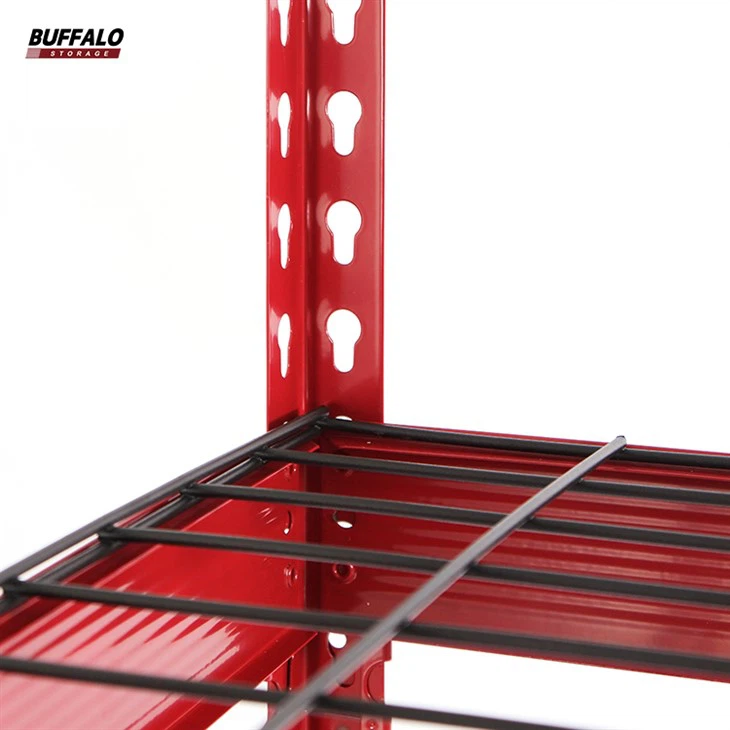
Hochleistungs-Stahlgestell 3
Diese Vorteile der selektiven Palettenregale es zu einer grundlegenden Speicherlösung für unzählige Lagerhaus Operationen. Die Mischung aus Zugänglichkeit, Flexibilität und Kosteneffizienz sorgt für eine hohe Investitionsrentabilität.
Mehr als selektiv: Welche anderen Arten von Palettenregal-Konfigurationen gibt es?
Während Selektive Palettenregale ist vielseitig, spezifisch Speicherbedarf erfordern manchmal unterschiedliche Palettenregal-Konfigurationenwobei die Dichte oft Vorrang vor der Selektivität hat:
| Regal-Typ | Selektivität | Dichte | Zugang Methode | Typische Rotation der Bestände | Hauptmerkmal |
|---|---|---|---|---|---|
| Selektiv | 100% | Niedrig | Standard-Gabelstapler | FIFO (verwaltet) | Direkter Zugang zu allen Palette |
| Drive-In / Drive-Thru | Niedrig | Hoch | Antriebe für Gabelstapler In | LIFO (Drive-In) / FIFO (Drive-Thru) | Gabelstapler betritt Gestell Struktur |
| Push-Back | Mittel | Mittel-Hoch | Standard-Gabelstapler | LIFO | Paletten auf Wagen/Rollen zurückgeschoben |
| Palettenfluss (Schwerkraft) | Mittel | Hoch | Standard-Gabelstapler | FIFO | Paletten Strömung auf geneigten Rollen |
| Paletten-Shuttle | Mittel-Hoch | Sehr hoch | Gabelstapler + Shuttle | FIFO oder LIFO | Halbautomatische Shuttle-Bewegungen Paletten |
| Kragarmregale | 100% | Besonderes | Standard-Gabelstapler | K.A. | Lagert lange/sperrige Gegenstände (Holz, Rohre) |
- Drive-In/Drive-Thru-Regale: Erlaubt eine Gabelstapler um direkt in den Gestell Struktur zum Speichern Paletten mehrere Tiefen. Angebote hochverdichtete Speicherung aber geringe Selektivität. Ideal für große Mengen identischer Produkte.
- Push-Back-Palettenregale: Paletten werden auf schrägen Wagen oder Rollen in jeder Bahn 2-6 tief gelagert. Wenn eine neue Palette geladen wird, schiebt es die vorhandenen zurück. Bietet eine höhere Dichte als ein selektives System und eine bessere Selektivität als ein Drive-in-System. Arbeitet nach dem Prinzip "Last-In, First-Out" (LIFO).
- Paletten-Durchlaufregale (Schwerkraftregal): Paletten werden an einem Ende einer leicht geneigten, mit Rollen ausgestatteten Bahn geladen und fließen zum anderen Ende zur Kommissionierung. Hervorragende Dichte und automatische FIFO-Rotation. Ideal für hochvolumige, datumsempfindliche Waren.
- Pallet Shuttle System: Ein halbautomatisches System mit einem ferngesteuerten Shuttle-Gerät, das Folgendes transportiert Paletten innerhalb der Gestell Struktur. Bietet sehr hochverdichtete Speicherung und kann für FIFO oder LIFO konfiguriert werden. Reduziert Gabelstapler Reisezeit.
Als Hersteller können wir auch Komponenten für diese Systeme produzieren oder uns vor allem auf die breit einsetzbaren Selektive Palettenregale, Sicherstellung der Spitze Produktqualität Und Haltbarkeit unabhängig vom Typ.
Wie bestimmt man die richtige Tragfähigkeit von Palettenregalen?
Sicherstellung der korrekten Tragfähigkeit ist wohl der kritischste Sicherheitsaspekt eines jeden Palettenregalanlage. Eine Überlastung kann zu einem katastrophalen Versagen führen. Bei der Bestimmung der Kapazität spielen mehrere Faktoren eine Rolle:
- Gewicht der Palettenladung: Berechnen Sie das maximale Gewicht eines voll beladenen Palette die Sie zu speichern beabsichtigen.
- Tragfähigkeit: Die Hersteller geben die maximale gleichmäßig verteilte Last an, die ein Paar von Balken sicher tragen kann. Diese Kapazität hängt ab von der Strahl Länge, Höhe (Stirnfläche) und Stahldicke. Entscheidend ist, dass dieser Wert pro Balkenpaar angegeben wird..
- Stehend Rahmen Kapazität: Dies ist komplexer und hängt von den Abmessungen des Pfostens, der Stahlstärke und dem Verstrebungsmuster ab, und der vertikale Abstand zwischen den Strahlenebenen. Je größer die freitragende Spannweite zwischen Strahl Stufen, desto geringer ist die Kapazität des Ständers. Die Hersteller bieten detaillierte Kapazitätstabellen an, die auf folgenden Faktoren basieren Strahl Abstände.
- Anzahl der Paletten pro Fach: Typischerweise, Palettenregalfächer sind für zwei Personen ausgelegt Paletten Seite an Seite pro Strahl Ebene, in breiteren Buchten könnten jedoch drei untergebracht werden.
- Sicherheitsfaktoren: Alle Kapazitätsangaben sollten Sicherheitsfaktoren gemäß den Industriestandards (wie RMI - Rack Manufacturers Institute in den USA) enthalten.
Bei der Konstruktion oder Änderung eines Palettenregalsystems sollten Sie unbedingt die vom Hersteller bereitgestellten Kapazitätstabellen und eventuell einen Ingenieur zu Rate ziehen. Als Regalproduktion Produktionsstättebieten wir klare Kapazitätsinformationen für unsere Palettenregalbalken Und Palettenregalrahmenund weist darauf hin, wie wichtig die Einhaltung dieser Grenzwerte für einen sicheren Betrieb ist. Qualität des Produkts wirkt sich direkt auf die Zuverlässigkeit Tragfähigkeit.
Wie können verstellbare Palettenregale die Lagerkapazität erhöhen?
Maximierung Speicherkapazität innerhalb einer bestimmten Lagerfläche ist für die meisten Unternehmen ein vorrangiges Ziel. Verstellbare Palettenregale Dies kann auf verschiedene Weise erreicht werden:
- Vertikale Raumausnutzung: Dies ist der offensichtlichste Vorteil. Palettenregale ermöglichen die vertikale Lagerung von Waren, oft bis zur Deckenhöhe (begrenzt durch die Gebäudestruktur und Gabelstapler Fähigkeit), wodurch sich die nutzbare Anzahl der Stauraum im Vergleich zur Bodenstapelung.
- Optimierte Regalhöhen: Die Einstellbarkeit der Balken ermöglicht es Ihnen, die Regalhöhen genau für die Paletten gelagert wird. Dies minimiert die Verschwendung von vertikalem Raum zwischen der Oberseite einer Ladung und dem Strahl darüber, wodurch mehr Ebenen in die gleiche Ständerhöhe passen als bei festen Regal Systeme.
- Optimierung der Gangbreite: Während Standard Selektive Palettenregale erfordert breitere Gänge für das Gegengewicht GabelstaplerDurch die Kombination mit verschiedenen Flurförderzeugen (z. B. Schmalgang-Schubmaststapler oder Drehschemel-Stapler mit sehr schmalem Gang) können die Gänge erheblich schmaler gestaltet werden. Dadurch wird der Platz im Gang in zusätzlichen Raum umgewandelt Stauraum für mehr Gestelle.
- Verbesserte Organisation: Eine gut organisierte Racksystem verhindert, dass Inventar verloren geht oder verlegt wird, und stellt sicher, dass alle vorgesehenen Palettenlagerung Standorte effektiv genutzt werden.

Robustes Metallregal 2
Durch die effiziente Nutzung der vertikalen Höhe und die Möglichkeit einer flexiblen Konfiguration, verstellbare Palettenregalanlagen sind grundlegende Instrumente zur die Speicherkapazität zu erhöhen und optimieren Lagerhaltung Dichte.
Warum eine Partnerschaft mit einem Hersteller von Palettenregalen für Ihren Lagerbedarf?
Die Wahl der Bezugsquelle für Ihre Palettenregalanlage ist ebenso wichtig wie die Wahl der Art der Gestell. Eine direkte Partnerschaft mit einem renommierten Regalproduktion Produktionsstätte wie uns, bietet erhebliche Vorteile, insbesondere für Kunden, die Wert auf Qualität und Zuverlässigkeit legen:
- Garantierte Produktqualität: Wir kontrollieren den gesamten Herstellungsprozess, von der Auswahl der Rohstoffe (Edelstahl) über die Präzisionsfertigung (Walzen, Stanzen, Schweißen) bis hin zur Endbearbeitung (Pulverbeschichtung). Dies gewährleistet gleichbleibende Produktqualität und die Einhaltung der Konstruktionsspezifikationen.
- Technisches Fachwissen: Wir haben internes Fachwissen in folgenden Bereichen Strukturdesign und Lastberechnungen. Wir wissen, wie die verschiedenen Komponenten zusammenwirken und können sicherstellen, dass die Racksystem erfüllt oder übertrifft die Anforderungen Tragfähigkeit Und Stabilität Normen.
- Schwerpunkt Produktlebensdauer: Wir bauen Gestelle entwickelt für den Einsatz in anspruchsvollen Lagerhaus Umgebungen. Unser Fokus auf Haltbarkeit bedeutet eine längere Lebensdauer und eine bessere Investitionsrendite für unsere Kunden, einschließlich der Händler von Lagerausrüstungen, die sich auf zuverlässige Produkte verlassen.
- Konsistenz und Zuverlässigkeit: Für Eisenwarengroßhändler, Einkäufer von Baumärkten und Vertriebsunternehmen ist es von entscheidender Bedeutung, dass sie Charge für Charge eine gleichbleibende Produktqualität erhalten. Die Fertigungskontrolle gewährleistet diese Zuverlässigkeit.
- Potenzial für Anpassungen: Wir bieten zwar Standard Palette von Palettenregalenkönnen wir spezielle Modifikationen oder Oberflächenbehandlungen vornehmen, um die Anforderungen unserer Kunden zu erfüllen. Speicherbedarf.
- Direkte Unterstützung und Rechenschaftspflicht: Die Zusammenarbeit mit der Quelle bedeutet direkten Zugang zu technischen Informationen, Unterstützung und klare Verantwortlichkeit für die Produktleistung.
Wenn Sie sich für einen Hersteller entscheiden, der auf Qualität, Sicherheit und Langlebigkeit setzt, investieren Sie in ein Speicherlösung die Ihr Inventar, Ihr Personal und Ihr Endergebnis schützt. Unser Engagement ist es, Folgendes zu bieten Palettenregallösungen dem unsere Kunden bedingungslos vertrauen können.
Häufig gestellte Fragen (FAQs)
Was ist der Unterschied zwischen rollgeformten und strukturellen Palettenregalen?
Rollgeformt Palettenregal (der häufigste Typ, oft mit Teardrop-Verbindungen) besteht aus gewickeltem Stahl, der durch Rollen geformt wird. Sie sind in der Regel leichter, weniger teuer und einfacher zu installieren/einzustellen. Strukturelle Palette Gestell wird aus warmgewalzten, miteinander verschraubten Baustahlkanälen hergestellt. Sie sind schwerer, robuster, bieten eine höhere Stoßfestigkeit und Kapazität, sind aber in der Regel teurer und weniger anpassungsfähig.
Wie oft sollten Palettenregale auf ihre Sicherheit überprüft werden?
Die besten Praktiken der Branche empfehlen regelmäßige Sichtkontrollen durch geschultes internes Personal (täglich oder wöchentlich) und gründlichere Kontrollen durch einen qualifizierten Gestell mindestens einmal jährlich von einem Fachmann überprüfen lassen. Bei den Inspektionen sollte auf Schäden (Beulen, Verdrehungen, Schrammen) an Pfosten und Balkenfehlende oder beschädigte Sicherheitsklemmen, überlastet Balkenund die richtige Verankerung. Eine rasche Reparatur oder der Austausch beschädigter Komponenten ist entscheidend.
Kann ich Palettenregalkomponenten von verschiedenen Herstellern mischen?
Es wird dringend davon abgeraten, Komponenten zu mischen (wie Balken und Stützen) von verschiedenen Herstellern zu verwenden, es sei denn, dies wurde ausdrücklich von einem qualifizierten Ingenieur oder den beteiligten Herstellern genehmigt. Unterschiedliche Konstruktionen, Stahlstärken und Verbindungsarten sind unter Umständen nicht kompatibel und können die des Regalsystems Tragfähigkeit und Sicherheit.
Wie schwierig ist es, verstellbare Palettenregale zu montieren?
Grundlegend Selektive Palettenregale Die Montage ist relativ einfach, erfordert jedoch die Einhaltung der Anweisungen und Sicherheitsmaßnahmen. Stehende Rahmen werden oft montiert geliefert. Die wichtigsten Schritte sind das Aufstellen der Rahmen, der Einbau der Balken in den gewünschten Höhen (wobei darauf zu achten ist, dass sie eben sind und die Sicherheitsklammern eingerastet sind) und die Verankerung der Grundplatten im Boden. Größere oder komplexere Installationen sollten von erfahrenen professionellen Installateuren durchgeführt werden.
Ist der Kauf gebrauchter Palettenregale eine sichere Option?
Einkaufen gebrauchte Regale kann Kosteneinsparungen bringen, birgt aber auch Risiken. Eine gründliche Inspektion ist unerlässlich gebrauchtes Lagersystem Komponenten auf Beschädigung, Rost oder Verformung. Die Kapazitätsangaben können unbekannt oder ungültig sein, wenn Komponenten vermischt oder beschädigt sind. Stellen Sie sicher, dass die gebrauchte Regale den geltenden Sicherheitsnormen entspricht, und lassen Sie es vor der Installation und Benutzung von einem qualifizierten Fachmann überprüfen.
Wie hoch ist die typische Lebensdauer eines Palettenregalsystems im Lager?
Bei ordnungsgemäßem Einbau, regelmäßiger Inspektion, rechtzeitiger Wartung und Betrieb innerhalb der angegebenen Belastungsgrenzen kann ein Qualitätsprodukt Palettenregalanlage können viele Jahre lang halten, oft 10-20 Jahre oder mehr. Haltbarkeit des ProduktsUmwelteinflüsse (Feuchtigkeit) und die Häufigkeit/Schwere der Stöße beeinflussen die Lebensdauer erheblich.
Die wichtigsten Erkenntnisse für Ihr Lagerhaus
Die Umsetzung der richtigen Palettenregalanlage ist von grundlegender Bedeutung für eine effiziente, sichere und produktive Lagerhaus. Denken Sie an diese wesentlichen Punkte:
- Anpassungsfähigkeit ist der Schlüssel: Verstellbares Palettenregal bietet unvergleichliche Flexibilität bei der Anpassung an wechselnde Bestände und maximiert die Stauraum.
- Selektive Regale sind vielseitig: Bietet direkter Zugang zu jeder PaletteDadurch ist es ideal für unterschiedliche Bestände und hohe Durchsatzleistungen.
- Die Kapazität ist entscheidend: Beachten Sie stets die Herstellerangaben Tragfähigkeit für beide Balken und Pfosten, um die Sicherheit zu gewährleisten.
- Auf die Komponenten kommt es an: Hoch Produktqualität in Pfosten, Balkenund Sicherheitsmerkmale tragen zur allgemeinen Stabilität Und Produktlebensdauer.
- Wählen Sie das richtige System: Berücksichtigen Sie bei der Auswahl zwischen Selective, Drive-In, Push-Back die Eigenschaften des Inventars, den Platz, die Ausstattung und das Budget, Palettenflussoder andere Palettenregal-Konfigurationen.
- Sicherheit hat Vorrang: Regelmäßige Inspektionen und Wartungen sind unabdingbar für die Aufrechterhaltung eines sicheren Speichersystem.
- Partner mit Qualität: Beschaffung bei einem seriösen Regalproduktion Produktionsstätte gewährleistet, dass Sie fachmännisch entwickelte, langlebige und zuverlässige Produkte erhalten. Palettenregallösungen.
Als erfahrene Hersteller sind wir bestrebt, erstklassige Produkte zu produzieren. verstellbare Palettenregalanlagen die den hohen Anforderungen unserer Kunden entsprechen. Wir verstehen die Bedeutung von robusten Strukturdesign und zuverlässig Tragfähigkeit. Entdecken Sie unser breite Palette von Palettenregaloptionen konzipiert für verschiedene Speicherbedarf. Erfahren Sie mehr über unser Engagement für Produktqualität und Langlebigkeit oder entdecken Sie die Vorteile unserer spezifischen selektiven Palettenregalsysteme. Benötigen Sie ein maßgeschneidertes Speicherlösung oder haben Sie Fragen zur Optimierung Ihrer Lagerhaltung? Kontaktieren Sie unser Team noch heute - lassen Sie uns eine bessere Racksystem für Ihr Unternehmen. Finden Sie das richtige industrielle Palettenregal oder entdecken Sie unsere complettes Regalsortiment.


